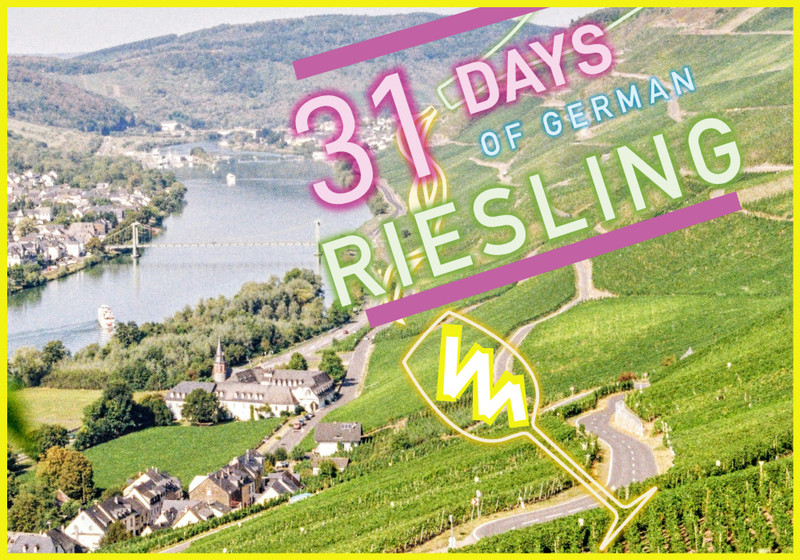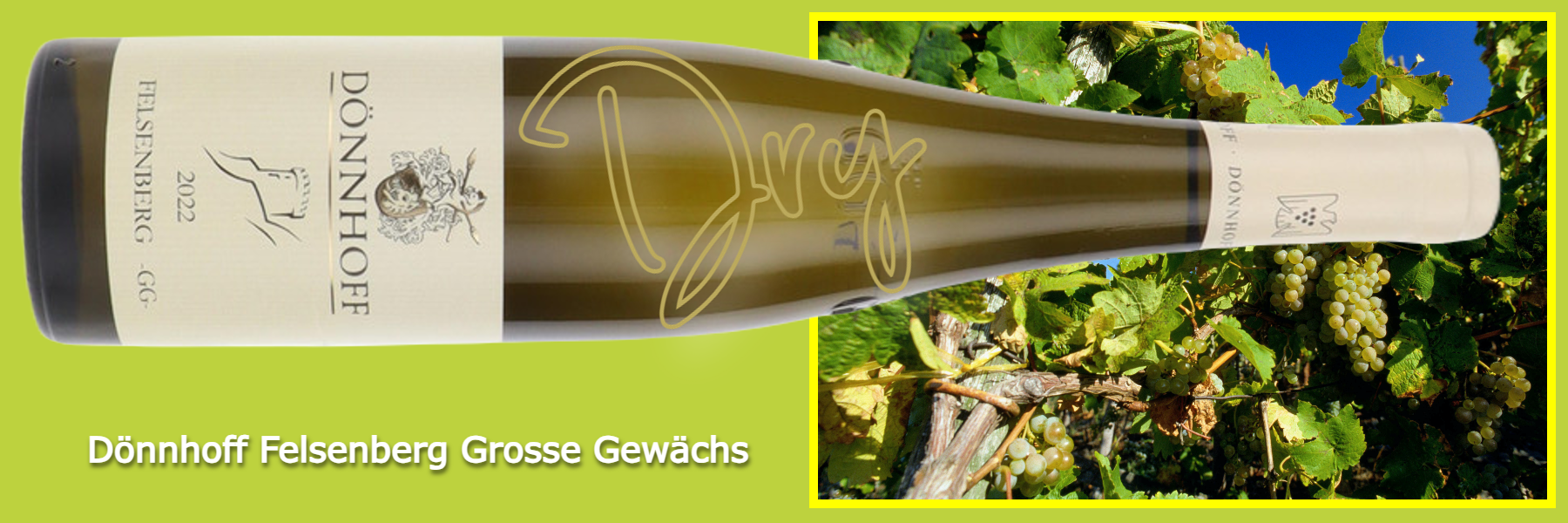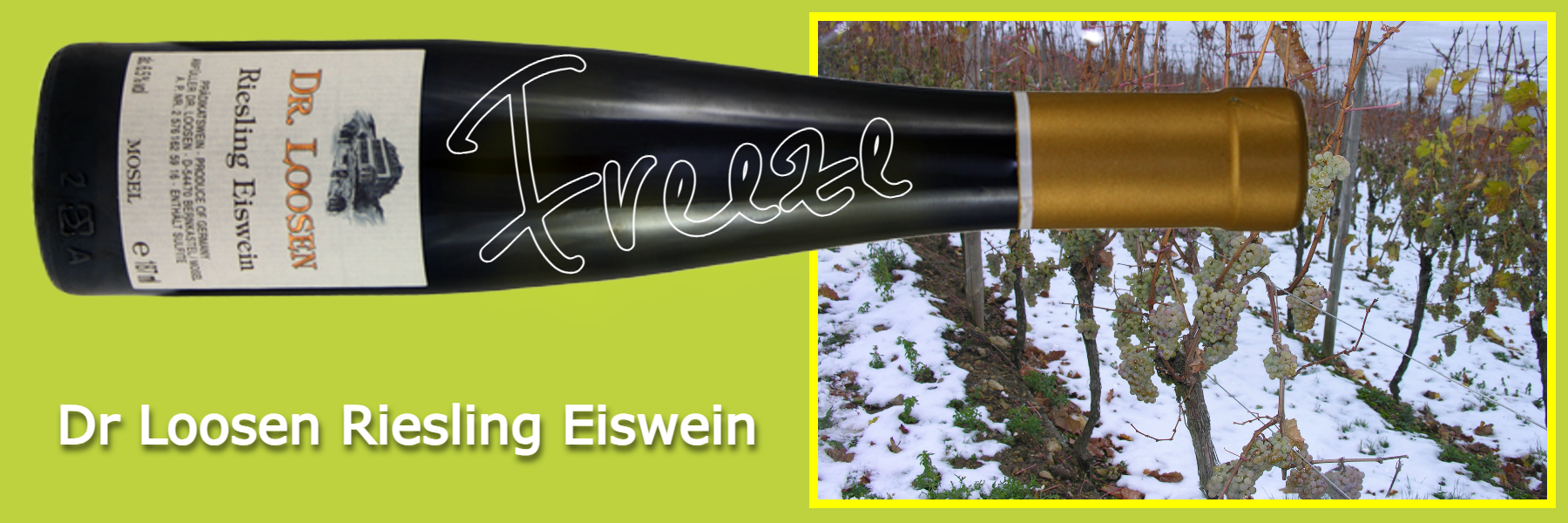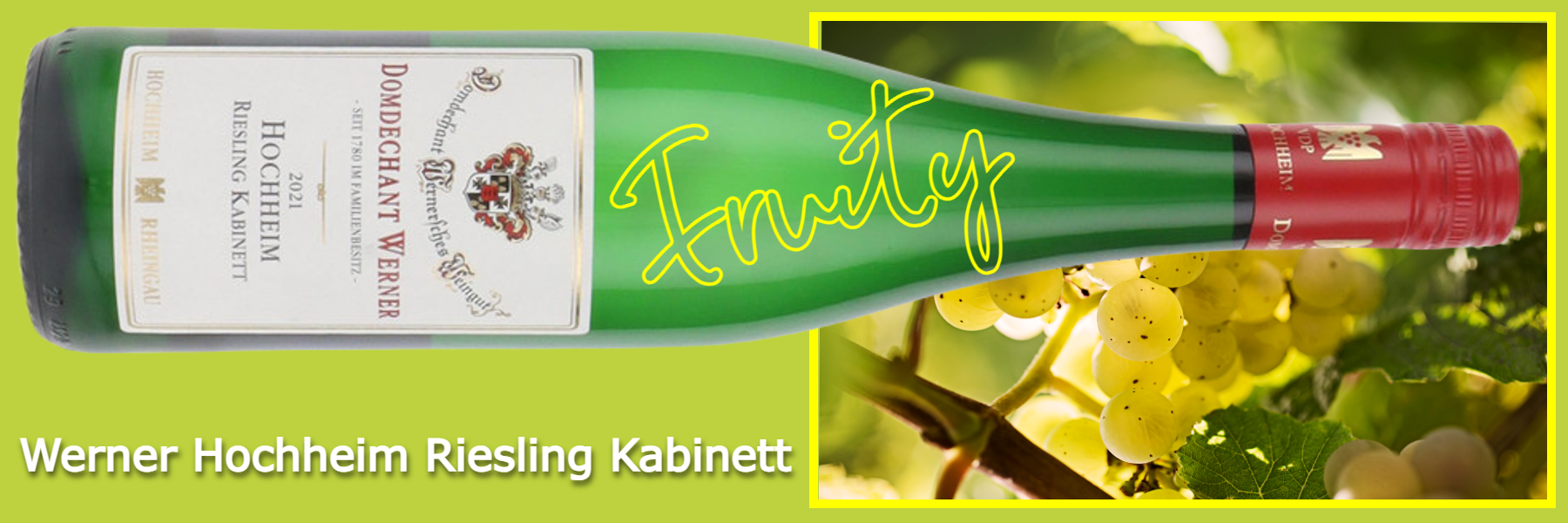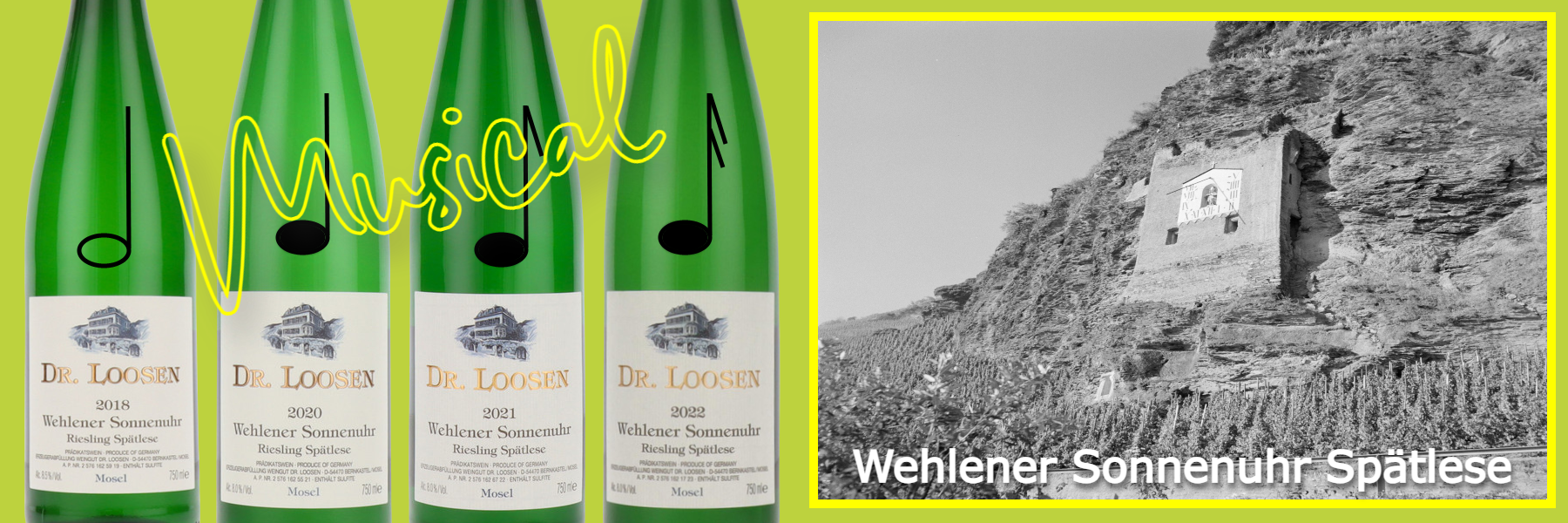German wine has often brought about a state of confusion in the minds of many consumers. It really shouldn't be this way. The labels, once written in impenetrable, archaic "Gothic script", have been simplified and can now be read by normal people without a degree in ancient languages. For example, the wonderfully named Nahe wine village of Schlossbockelheim would be correctly written as Schloßböckelheim using the "eszett" and "umlaut". It helps if you did German at school, but we Brits are generally rubbish at learning other people's languages!
Wine labels will also tell you how ripe the grapes were at harvest and whether they've been allowed to have their sugar levels adjusted (Qba: Qualitätswein bestimmter Anbaugebiete), or the various levels of Qualitätswein mit Prädikat (Qmp) which must keep their natural sugar levels. Many of these wines may be fermented to full dryness, so look out for the word "Trocken" after the "Spätlese" or "Auslese" designation.
Just when you thought it was all beginning to make sense!
Also, German producers will tell you that their customers like to drink all styles of wine from a particular vineyard, so you'll see the same vineyard offering both normal ripeness grapes and wines offering riper, late harvest grapes. Letting the grapes stay on the vines for an extended period is a risky business as, in the cooler vineyards, harvesting might not even begin until mid October at the earliest. Bad weather can easily wipe out a potentially perfect crop with just one heavy downpour ruining the grapes from which you're hoping to make a fantastic Auslese. Picked a day earlier and your vineyard will be profitable, with a higher quantity available for marketing as a "normal" wine. As I said, it's risky keeping all your customers happy.
Other countries just don't operate their vineyards this way and will harvest everything in one go when conditions are as near to perfect as possible.
I once visited a Saar winery, based in an old Schloss (castle), where they were serving hot, pumpkin soup to the poor souls (including myself) who were shivering from the cold wind whistling along the river valley. Surprisingly, considering the time of year, the grapes were still waiting to be picked. They said the harvest wasn't due for at least another three weeks as the grapes weren't yet ripe, which would have meant taking it well into November. And that was for a normal harvest. It could have been snowing by then and they weren't trying to make an Eiswein. Global warming certainly wasn't a consideration back then and the name hadn't even been coined yet.
Growing Riesling in a marginal climate, of course, is ultimately the reason for this utter chaos, but also brings the sheer joy of drinking such wines when the bottles show perfect balance. Even apparently ordinary wines, given plenty of bottle age, will blossom into those with spectacular aromas and flavours, whether made as a dry, or sweet style.
These days, many of Germany's top wines are made in a dry style. This is actually the traditional method from centuries ago and rare bottles from the 18th and 19th century can still be found in some grower's cellars. Single vineyard wines, based on old wine maps from the 1700s, now command high prices with many being sold for £50 - £100 a bottle. Considering the prices of First Growth Bordeaux and Grand Cru Burgundy (in the £1000s), these new, dry Riesling offer incredible value, so look out for bottles labelled with the VDP association (Verband Deutscher Prädikats) "eagle" logo. Some of these wines may be red (Spätburgunder/Pinot Noir), but most are classic Riesling wines which are capable of ageing for many decades. They are delicious!
With limited yields from their vines , Erste Lage is the equivalent of a "Premier Cru" vineyard and Grosse Lage equates to a "Grand Cru" site. A Grosses Gewächs label designation denotes a dry wine produced from the greatest vineyards of Germany. Frazier's stocks GG from Dönnhoff (Nahe), Dr Loosen (Mosel), and Guntrum (Rheinhessen).
Many years' ago, my first ever visit to a wine region was to Germany when I was only 18 years' old. I was awarded the WSET "Walter Sichel" Scholarship trip after achieving a Distinction in the "Higher Certificate" exam. Sichel, the maker's of the infamous Blue Nun (and I really mean, infamous!) were sponsoring the Germany question in the follow-up examination and, luckily, I chose to answer it well enough to get to join the once-a-year tour with others from all over Europe and the US. The downside? I wasn't keen on the traditional German food being offered. Lots of plain, boiled meat/sausage and sauerkraut. Such variety. Mmmm!!!
The visit involved meeting Sichel-connected producers who, thankfully, made far higher quality wines on their own estates than the awful (but somehow popular) Blue Nun Liebfraumilch. I remember some excellent Rheingau Kiedricher wines from Robert Weil and some Forster Jesuitengarten (producer unknown) from the Pfalz of a similar quality. A week of touring the vineyards showed how difficult it was to grow Riesling on almost inaccessible slopes in the Mosel valley and the dedication required to aim purely for quality. So steep, the vineyards had to be worked entirely by hand and the best growers' sites in other regions followed the same principles of minimal intervention in the vineyards.
I particularly remember trying the latest "dry" wines (mostly picked at only Qba ripeness level) at a local Rhein wine fair, which really were akin to bottled battery acid. So painful on the palate with ultra high acidity enough to strip tooth enamel and completely out of balance. How times have changed since then with VDP dry wines being rivals to the top whites made anywhere in the world.
At the other extreme, on the very last day of the visit, it was back to the Blue Nun laboratory to sample all the dessert wines made from Riesling grapes. Paired with endless bowls of fresh strawberries, the sweet Beerenauslese (extra ripe grapes affected by noble rot fungus), Trockenbeerenauslese (ultra ripe and dry/raisin-like berries) and Eiswein (frozen grapes of minimum Beerenauslese ripeness) were truly heavenly to taste.
Moving on several decades, on a later tour of the Mosel, I was privileged to visit and taste at the estate of Max Ferd Richter. Here, they make a sublime range of dessert wines including TBAs from vineyards in both Wehlen and Brauneberg, along with an exquisite Mülheimer Eiswein. These wines are some of the very best sweet wines produced anywhere in the world, rare and extremely expensive to buy, but getting to taste them was an incredible experience.
A recent 2021 vintage of the MFR Wehlener TBA was rated 99/100 points by the Wine Advocate and has a projected drinking window of up to 80 years!
"Selected from the Auslese bucket, the TBA raisins were pressed with 200° Oechsle and gave no more than 30 liters of the 2021 Wehlener Sonnenuhr Riesling Trockenbeerenauslese. This is brilliantly clear and aromatic as well as savory on the rich and concentrated but utterly precise nose that is more on the lemon side rather than the tropical fruit side. Enormously rich and viscous on the highly refined and elegant palate that integrates the acidity of 16.8 grams per liter perfectly, this is a fantastic TBA that doesn't really taste sweet (I mean it certainly does) because the savory and citric finish makes it so digestible and fresh. This is definitely a star of the vintage."
The 2019 achieved the same, near perfect, score and both vintages sell for over £200 a HALF bottle. I'll have a case.
An older, 2001, MFR Mülheimer Eiswein also received a 99/100 score. Are you beginning to see a pattern here?
"An awe-inspiring wine, the white-peach-scented 2001 Riesling Eiswein Mulheimer Helenenkloster has an unreal personality. It appears to have the weight of a Trockenbeerenauslese yet the balance and purity of an Eiswein. Red currants, peaches, tangerines, cherries, apricots, chamomile, pineapples, and raspberries are among its stunning panoply of flavors. Medium to full-bodied and oily-textured, this wine is thick yet razor sharp as well as syrupy yet balanced. It is a tour de force in winemaking!"
How many grape varieties, other than Riesling, can offer such a broad range of sweet styles? If you've got a sweet tooth, you really need to try some of these wines.
Dr Loosen is no slouch either at making great Mosel wines and his Eiswein is available from Frazier's right now.
Since the introduction of the 1971 German wine laws, with quality being defined by the sweetness of the grape must at harvest, the favoured style with consumers has probably been an "off dry" one. Whether medium-dry, or medium-sweet, the labels from the better estates were likely to be marked as a "Kabinett", or use the late-harvest name "Spätlese" for the sweeter wines. At the lower end of the market, the designation "Qualitätwein" would be seen more commonly, with regional groupings of vineyards (rather than individual "einzellage" sites) with names like Piesporter Michelberg and Niersteiner Gutes Domtal being particularly popular in the UK. These "grosslagen" names were really a bit of a con as usually the wines made would rarely contain any grapes from the actual named villages and could often be a blend of grapes sourced from up to 20 different villages miles from the supposed location. Most customers really didn't care about such things and just wanted their favourite bottles at cheap prices.
This is all about to change!
With an update to the wine laws made in 2021, these names will all have to disappear from the 2026 vintage labels. If you see a Piesporter bottle in the future, it really will have to come from there. As it should. You'll still be able to buy a single vineyard Piesporter Goldtröpfchen, but the Michelberg name will only be used as a regional one using the term "Bereich Michelsberg". Will customers notice the change? There's bound to be more confusion, but a £10 bottle is never going to be the same quality as a £20 one. You pay your money...
"Kabinett" is the lowest level within the "Prädikat" system and will produce wines which are light and delicate. The grapes must achieve a ripeness level within set parameters (known as degree "Oechsle") and the alcohol levels can vary from 7%-8% up to 12%-13% for the drier wines. Levels vary from region to region and for different grape varieties. No chaptalisation (sugar adjustment) is allowed in any of these Qmp wines.
"Spätlese" is the next category up the scale and relies on grapes being harvested later than normal to achieve a naturally higher sugar content. The wines made are generally richer in texture and more full-bodied. Many are medium-sweet to sweet in style, but some are fermented to dryness.
"Auslese" is an even riper level with selection made by individual bunches rather than using the whole harvest. Sometimes, the grapes are affected by noble rot (botrytis/edelfäule) and the wines made are usually sweet. Some producers use gold capsules on their bottles to denote an extra level of sweetness, others use a *, **, or *** star designation to differentiate their Auslese wines. More confusion for the poor old consumer, especially when some of these wines may be dry!
So, after all the techno-babble, what really makes German Riesling better than those made elsewhere?
German Riesling wines are often considered superior to those produced elsewhere for several compelling reasons, rooted in the unique combination of Germany's terroir, climate, winemaking traditions, and meticulous craftsmanship. These elements collectively contribute to the exceptional quality and distinctiveness of German Riesling.
Terroir and Climate
One of the fundamental reasons for the superiority of German Riesling lies in the country's unique terroir. Germany's wine-growing regions, particularly the Mosel, Rheingau, and Pfalz, boast a combination of slate soils and steep, south-facing slopes. The slate soils play a crucial role in imparting a distinctive mineral character to the wines while aiding in heat retention, which helps grapes ripen in the cooler climate. The steep slopes ensure optimal sunlight exposure, essential for the Riesling grape to achieve full ripeness while maintaining high acidity. This combination of soil and topography is rarely replicated elsewhere with the same effectiveness.
Germany's cool climate further enhances the quality of its Riesling. The slow ripening process, typical of cooler climates, allows grapes to develop complex flavours and aromas while preserving their natural acidity. This results in wines that are not only aromatic but also balanced, with a refreshing crispness. In warmer climates, Riesling grapes tend to ripen too quickly, leading to wines that can be overly fruity and lack the nuanced acidity and structure that characterise German Riesling.
Winemaking Traditions and Practices
Germany's long-standing winemaking traditions play an essential role in the distinction of its Riesling wines. German winemakers have centuries of experience and a deep understanding of the Riesling grape, enabling them to employ techniques that bring out the best in the fruit. Traditional methods, such as selective hand-harvesting and precise fermentation processes, are meticulously followed to ensure the highest quality. The emphasis on craftsmanship and attention to detail is evident in every bottle.
Moreover, the classification system in Germany, particularly the Prädikatswein system, provides a framework that emphasises quality. This system categorises wines based on the ripeness of the grapes at harvest, ranging from Kabinett to Trockenbeerenauslese, each level offering a different expression of the grape. This rigorous classification ensures that consumers can trust the quality and style of the wine they are purchasing.
Diverse Styles and Versatility
German Riesling wines are renowned for their versatility and range of styles, from bone-dry to lusciously sweet. This diversity is largely a result of the winemakers' ability to harness the natural acidity and sugar levels of the grape, creating wines that can suit a wide array of tastes and occasions. The ability to produce such a broad spectrum of wines while maintaining high quality is a testament to the skill and expertise of German winemakers.
Additionally, German Riesling has an extraordinary ageing potential. The high acidity and sugar content allow these wines to evolve beautifully over time, developing complex tertiary aromas and flavours. A well-aged Rhein or Mosel Riesling can exhibit a remarkable depth and richness that is rarely matched by Riesling from other countries.
Conclusion
The superiority of German Riesling wines is a product of the harmonious interplay between the unique terroir, cool climate, centuries-old winemaking traditions, and meticulous craftsmanship. These factors collectively contribute to their distinctive character, balance, and complexity, setting them apart from those wines produced elsewhere in the world. Whether enjoyed young, for their vibrant fruitiness and crisp acidity, or aged for their profound complexity, German Riesling consistently offers a remarkable wine experience that is difficult to replicate.
On a purely personal note, I think Riesling wines are like your favourite songs (or bands). Any changes in the growing season, the age of the vines increasing each year allowing the roots to reach new depths in the soil and accessing a different mineral make up and flavour profile, and when you choose to open and drink your precious bottle is like changing the notes in a tune, or getting a new singer or guitarist. The songs are still the same, but the interpretation evolves ever so slightly with each change. German Riesling wines seem to work in the same manner and, if you've tried a vertical tasting of vintages for one of your favourite wines, you'll understand my reasoning behind this thought.
I'm in pure heaven with a glass of German Riesling in my hand and the latest track turned up to eleven!

